Picture this: You’re walking down the street, surrounded by bustling shops, restaurants, and billboards.
Something catches your eye—an ad for a brand-new smartphone. You don’t click it. You don’t even stop.
But hours later, when you’re home browsing for a phone online, that same ad pops up again.
Suddenly, you’re interested.
That’s the power of display advertising. It’s not the in-your-face tactic but the subtle nudge that keeps brands on your radar.
In this article, we’ll dive into the latest display advertising stats that show how this strategy boosts brand awareness, engages potential customers, and drives results when paired with the right approach.
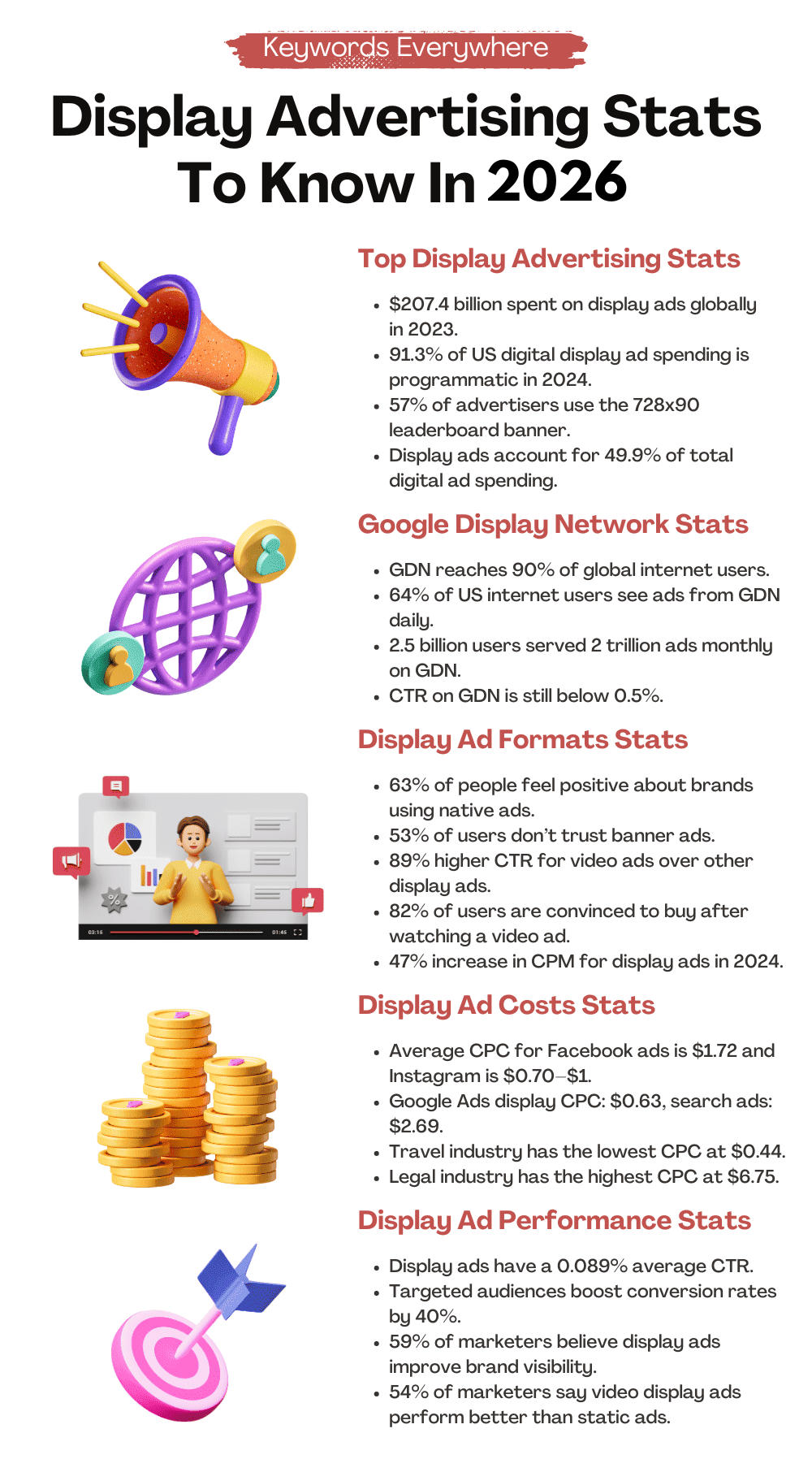
What is Display Advertising?
Display ads are visual ads you see on websites, social media platforms, and other online spaces like your favorite blog or YouTube channel.
They can take the form of banner ads—those rectangular images you often find at the top or sides of a webpage. Then there are video ads—short clips that play before, during, or after the content you’re watching.
For instance, when you visit a site and notice a bright banner promoting a new toy or a catchy video showing off the latest fashion trend, you’re seeing display ads doing their job.

General Display Advertising Stats
Display advertising has grown a lot over the years and is now a major part of online ads.
Let’s look at some key display advertising stats that highlight how it’s changed and what it can do for businesses in 2025:
1. In 2023, people spent around $207.4 billion on display ads worldwide, making it the top digital ad format. By 2026, this number is expected to grow to $266.6 billion.
2. In the US, programmatic advertising will account for 91.3% of all digital display ad spending in 2024, according to a forecast from June 2024 by emarketer. That’s about $156.82 billion. Although the growth rate of programmatic ads has slowed, it will still grow by 15.2% in 2024.
3. The most popular banner ad size is 728 x 90, known as the leaderboard, used by 57% of advertisers.
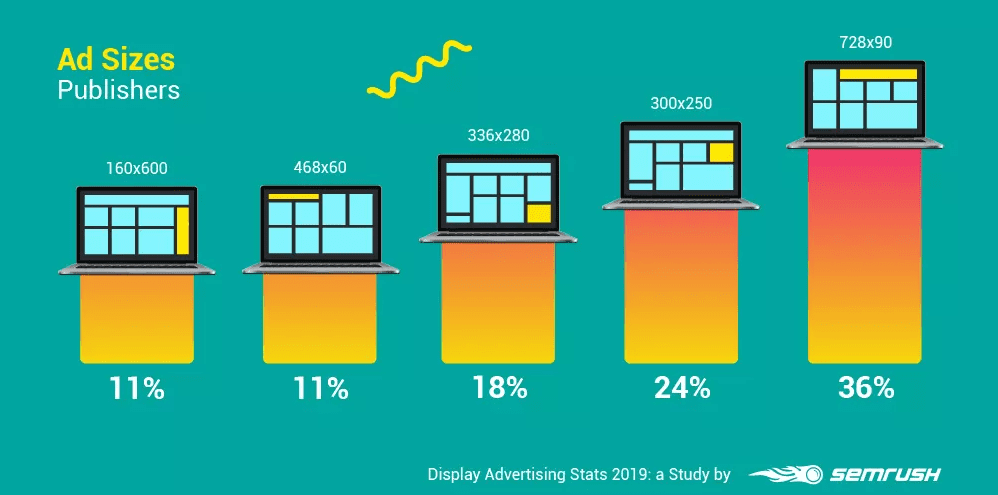
Source
4. Google’s display ad network is the biggest, reaching 90% of internet users globally. It includes over 35 million websites and apps, plus Google’s own properties.
5. Responsive ads are becoming more popular. A Semrush study found that 72% of image ads are now responsive, compared to 28% for standard image ads.
6. Cross-device targeting is crucial for success with display ads, as online shopping ads are evenly distributed across different devices.
7. On Google’s display network, the average cost-per-click (CPC) is $0.63, while on the search network, it’s $2.69—more than four times higher. This is because clicks on the search network are generally more valuable.

Source
8. A study found that 53% of customers pay more attention to native ads than to display ads.
9. Even though 43% of marketers think display ads are the least effective, 84% are still investing in them.
10. According to Keywords Everywhere search widget, more than 5 million people search for “Google ads” each month. This shows the importance of Google Display Ads for reaching a larger audience and increasing brand awareness.
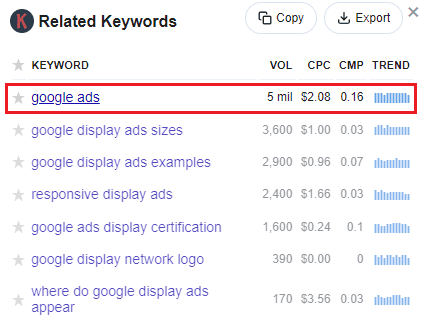
Google Display Network Statistics
Google display ads appear on apps and websites that belong to the Google Display Network (GDN), but there are other networks available too.
The GDN includes over two million sites and apps, reaching about 90% of internet users.
This huge reach is a double-edged sword: while you can show your brand to a lot of relevant people, there’s also a chance you might reach a lot of people who aren’t interested.
Here are some important display advertising stats to help you make the most of the Google Display Network:
11. The Google Display Network(GDN) reaches a solid 90% of internet users worldwide and up to 94% of internet users in the US.
12. Every day, 64% of US internet users and 89% of US smartphone users see ads from the GDN.
13. The GDN delivers over 2 trillion ad impressions to 2.5 billion users each month across more than 2 million websites.
14. For top e-commerce sites using the GDN, ads are fairly evenly split between image ads and responsive ads. Publishers often test different ad types to see which ones get better results.
15. While the GDN is mainly used for finding new customers and building brand awareness, its average click-through rate (CTR) is still under 0.5%. Despite this, it’s a solid option for reaching people beyond search engines and social networks.
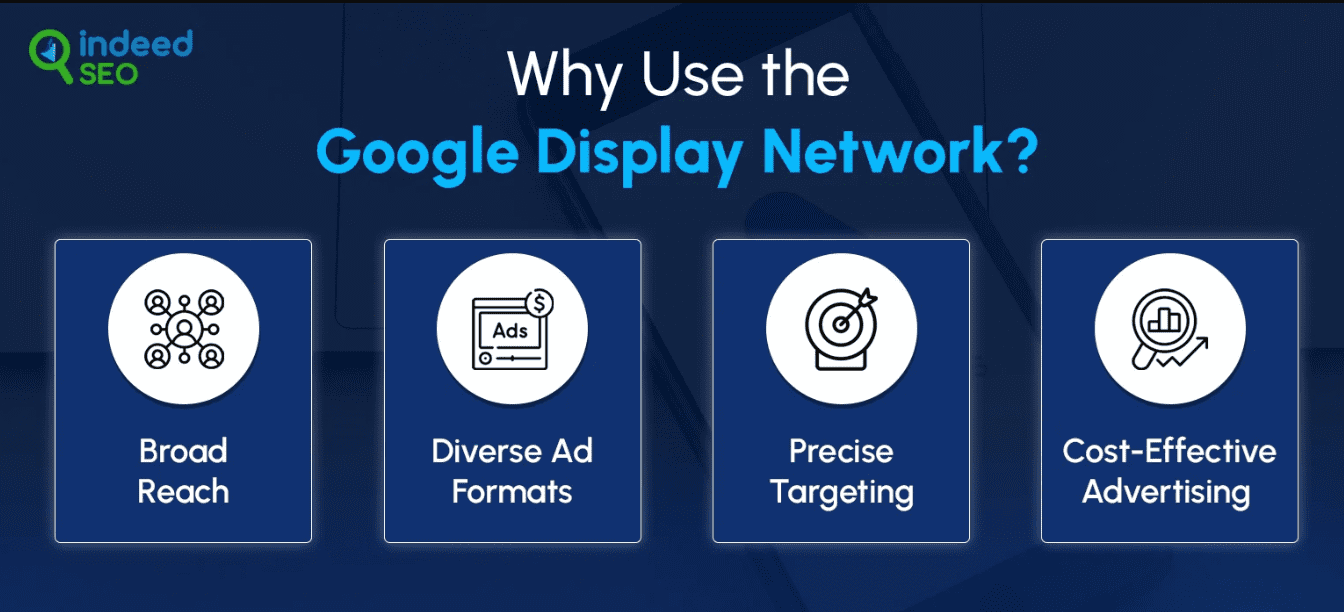
Source
Display Ad Format Statistics
When getting into display advertising, it’s crucial to understand the different types of ads and targeting options available to connect with your audience.
Think of display ads as various tools in your marketing toolbox: you’ve got banner ads, pop-ups, videos, rich media ads, native ads, social ads, traditional ads, responsive ads, and more.
So, how do you know which type of ad will work best for you?
These display advertising statistics will guide you in picking the most effective ad format for your digital marketing strategy.
16. Banner ads continue to be a reliable choice, delivering solid results. Sunshine Company saw a 2% click-through rate (CTR) and a 50% boost in site traffic using 300×250 banner ads on industry-specific blogs.
17. Video ads are capturing attention like never before. TrueTech Co.’s 1-minute product videos on YouTube gained over 500,000 views and cut their cost-per-click by 35%.
18. Native ads are also making waves. About 63% of people said they felt good about a brand after seeing native ads. Acme Co. increased their lead generation by 75% using native ads that looked like articles on industry forums.
19. When it comes to grabbing active attention, interscroller and video ads are top performers. You must aim for a minimum of 2.5 seconds of active attention for all your ads.
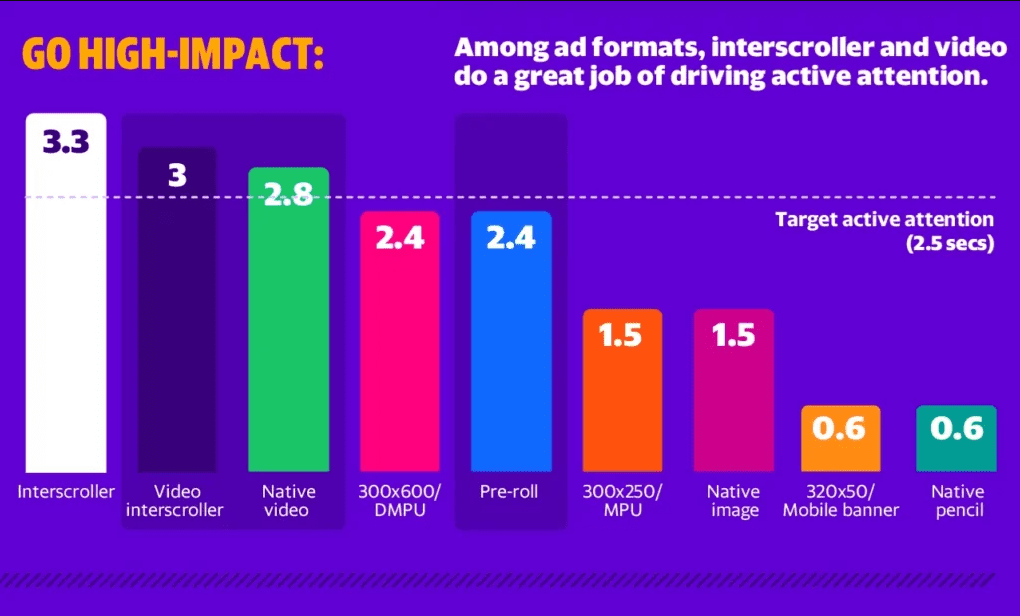
Source
20. The average CPM (cost per mille/thousand) for display ads is:
- Banner ads: $2-$20 per thousand impressions
- Video ads: $20-$50 per thousand impressions
- Native ads: $10-$100 per thousand impressions
21. A report shows that in Q2 2024, the cost per thousand impressions (CPM) for display advertising jumped by 47% compared to the previous year. This rise indicates that ad spending is bouncing back to more normal levels, especially after the budget cuts and low expectations seen in Q2 2023.
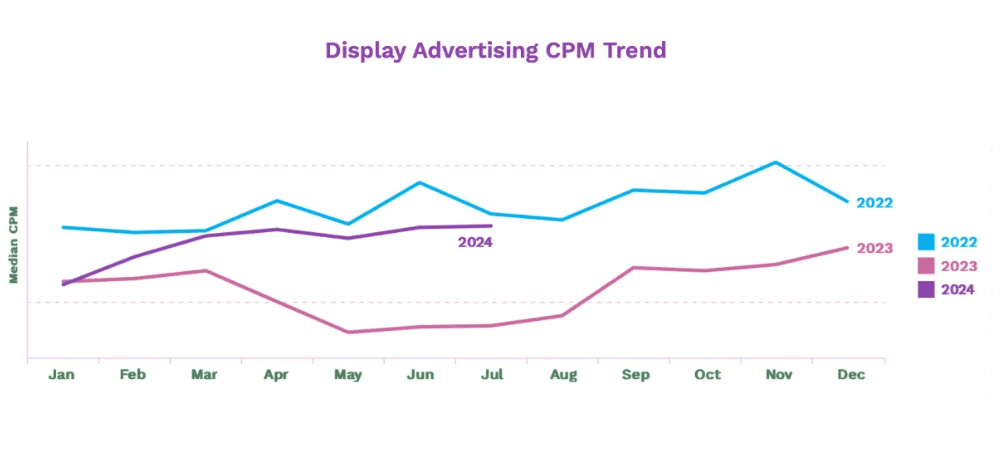
Source
22. Native ads are viewed about 53% more than banner ads. Plus, 32% of people said they’d share a native ad with family and friends versus 19% for banner ads.
23. Trust is a big factor—54% of users don’t click on banner ads because they don’t trust them. However, native ads with rich media can increase conversion rates by up to 60%.
24. According to Bannerflow, display ads with video have an 89% higher click-through rate.
25. Video ads are incredibly effective, with Wyzowl reporting that 82% of users were persuaded to shop a product or service after watching a video.
26. Programmatic advertising is growing rapidly because of its automated ad buying and cost efficiency. In 2021, it was worth $49.5 billion. It’s expected to grow from $56.28 billion in 2022 to $138.25 billion by 2030, with an annual growth rate of 13.70% during this time.

Source
Display Ad Costs Statistics
We know that display ads usually cost less than search ads, but how much do they really cost?
The price can change based on several factors, like who you’re targeting and how much you’re willing to spend.
Here’s some key information you should know about display ad costs:
27. The average cost per click (CPC) for a Facebook ad is $1.72. This number includes all industries, so some extremes can change the average. For instance, the finance industry has a high average cost at $3.77, while retail is much lower at $0.70.
28. For Instagram display ads, the average CPC falls between $0.70 and $1.
29. If you’re targeting people aged 18 to 34, expect to pay more for your Instagram ads. Why? Because younger folks, like millennials and Gen Z, are really good at ignoring ads, making it pricier to grab their attention!
30. On Google Ads, the average CPC is $2.69 for search ads and $0.63 for display ads. This is higher than the averages for Facebook and Instagram, so it’s something to think about when deciding where to run your ads.
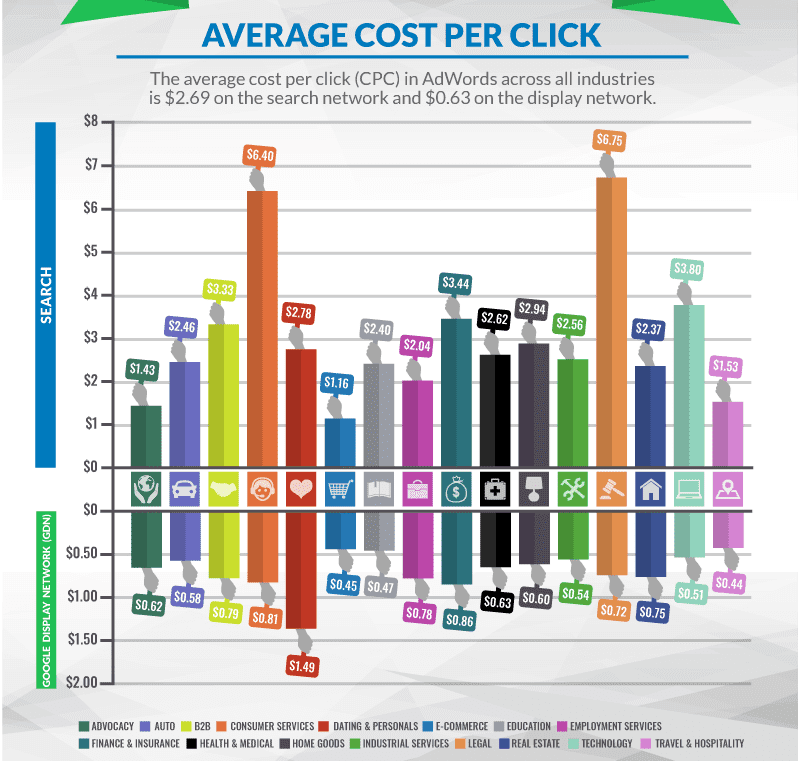
Source
31. When looking at different industries, a study found that the travel and hospitality sector has the lowest CPC at $0.44.
32. Overall, display ads generally have lower CPCs than search ads, which can sometimes cost 4 to 5 times more, depending on the industry and keywords you choose.
Display Ad Performance Statistics
The performance of your display ads is just as important as their cost—you want to make sure you’re putting your money into a platform that delivers results.
Here are some key display ad stats to keep in mind:
33. Viewable display ads in the Display Network have 4 times higher conversion rates compared to those that don’t meet the MRC standard.
34. Display ads have the lowest click-through rate (CTR) of all ad types at just 0.089%. They’re mostly used for branding rather than generating clicks.
35. The click-through rate can change based on where the ad is placed on the screen and its format (shape and size). Traditional full banners don’t perform well compared to skyscrapers or medium and large rectangles.
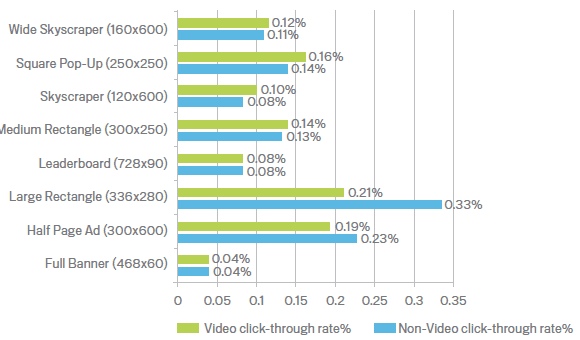
Source
36. You can boost conversion rates by 40% or more by combining targeted audiences with display remarketing campaigns.
37. According to HubSpot, people often dislike display ads more than text-only search ads, with many finding display ads annoying during their viewing experience.
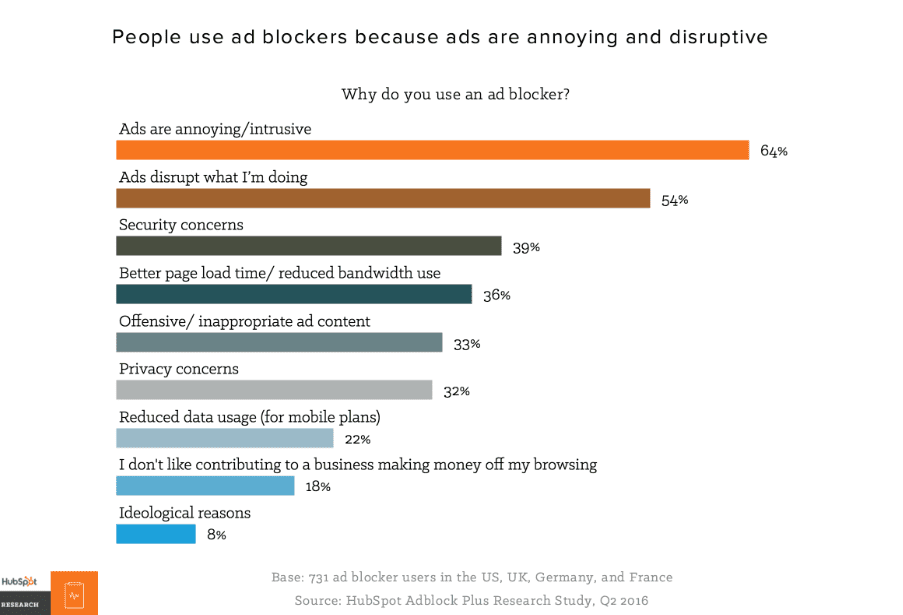
Source
38. Marketers using smart display ads see a 20% increase in conversions while maintaining the same cost per acquisition (CPA) compared to those using standard display ads.
39. A retargeting campaign by Magoosh Online Test Prep generated $58,608 in revenue, costing only $11,000, resulting in an impressive ROI of 486%.
40. Airbnb achieved an engagement rate of more than 4% with one of their promoted tweets.
41. Heineken Light reached 54% of their audience—about 35 million people—in just three days using video ads on Facebook.
42. Julian Bakery experienced a 35% increase in conversions and a whopping 330% increase in impressions on the Google Display Network (GDN).
43. While 71% of publishers reported no major complaints about native ads, 29% faced some minor backlash.
44. In a survey about the usefulness of ads, mobile users said that display ads are the least valuable. They tend to find search ads more helpful because these ads are more relevant to what they are looking for.
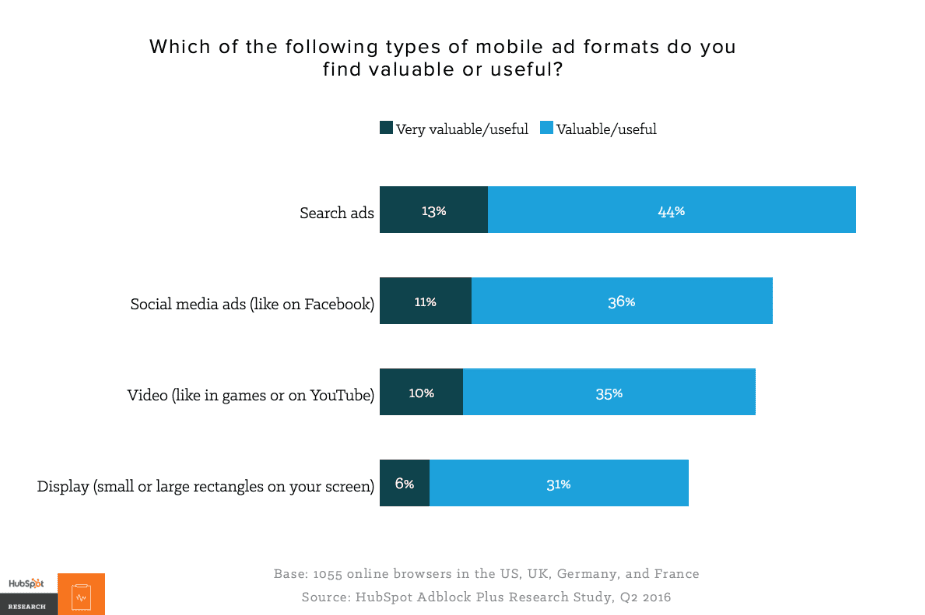
Source
Display Ads For Business Statistics
Businesses rely on display advertising to boost their visibility and connect with a bigger audience. These ads are designed to grab the attention of potential customers as they browse online.
By placing display ads on websites that their target audience visits, businesses can increase brand awareness and drive more traffic to their sites.
Here are some important display advertising stats that reveal how businesses are using display ads and the benefits they’re seeing:
45. 16% of advertisers’ budgets go toward display advertising, and 55% of companies use display ads to promote their brands.
46. After seeing a display ad, about 27% of consumers search for the business, leading to a 59% increase in conversions when they do.
47. 92% of marketers say that retargeting display ads work just as well, or even better, than search marketing.

Source
48. When someone searches after viewing a display ad, there’s a 59% higher chance they’ll convert.
49. After seeing a display ad, users’ search activity for a specific term or brand jumps by 155%.
50. One study found that retargeting display ads boosted brand-related search queries by 1,046% and increased website traffic by 726%.
51. The average click-through rate (CTR) for retargeting display ads is 0.7%, which is 10x higher than regular display ads, which sit at 0.07%.
52. Visitors who’ve been retargeted with display ads are 70% more likely to convert.
53. Display ads drive 12% of website traffic, making them a key part of any marketing strategy.
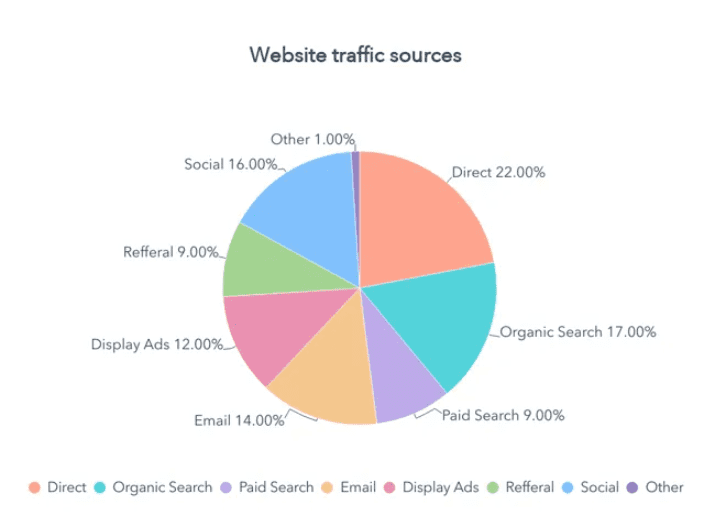
Source
54. 99% of social media users access apps, so optimizing display ads for mobile can help you reach the most customers.
55. With 87% of American adults owning a connected TV (CTV), ads on streaming platforms are an effective way to reach your audience.
56. Privacy concerns are growing, especially with ad fraud, where cybercriminals pose as businesses to profit from fake clicks, costing businesses $120 billion a year.
57. Brands that use sponsored display ads see a 15% year-over-year increase in sales.
Challenges in Display Advertising Statistics
Like other forms of online marketing, display advertising has its own challenges that businesses need to handle. These display advertising stats highlight some of the common hurdles companies face:
58. The average click-through rate (CTR) for all display ads across all formats and placements is only 0.06%.
59. Ad blocking has increased by 41% worldwide in the past year, with 198 million active ad blockers globally.
60. The Keywords Everywhere widget shows a high number of searches for terms related to “Adblock,” indicating that many internet users don’t want to see display ads, so businesses need to find new ways to reach them.
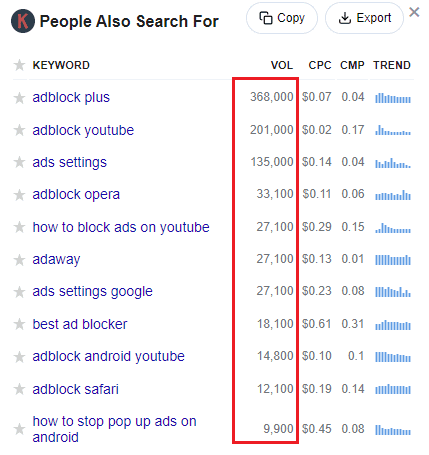
61. A study found that only 2.8% of people thought the ads on websites were relevant.
62. A 2014 study revealed that 18- to 34-year-olds are much more likely to ignore online ads, like banners and social media ads, compared to traditional ads on TV, radio, and in newspapers.
63. More than 50% of clicks on mobile ads are accidental, and 33% of internet users find display ads completely intolerable.
64. A 2013 study showed that 28% of people admitted to hiding their activities from advertisers—only criminals ranked higher.
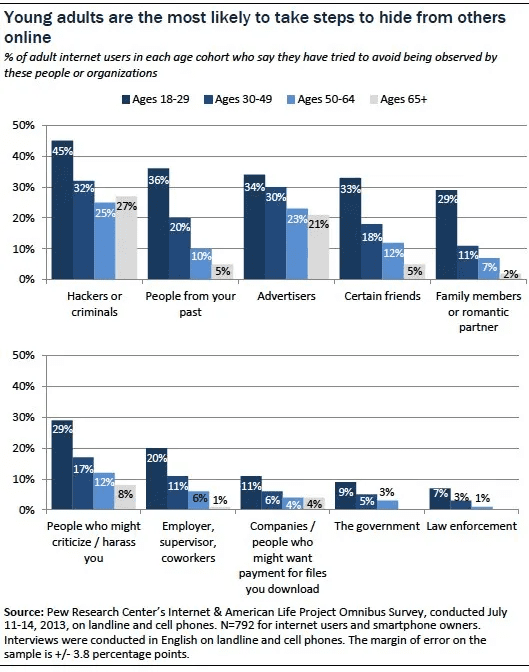
Source
Conclusion
Display advertising is a powerful instrument in digital marketing. Eye-catching banner ads, engaging video ads, and interactive rich media ads help businesses reach a bigger audience and improve brand visibility.
As we can see from these display advertising stats, this area has been growing steadily due to new technology and changes in how people use the internet.
Targeting and personalization are key to making display ads more effective. By using these strategies, advertisers can ensure their ads reach the right people at the right time.
This leads to higher conversion rates and more successful campaigns. Clearly, display advertising plays an important role in digital marketing today.


